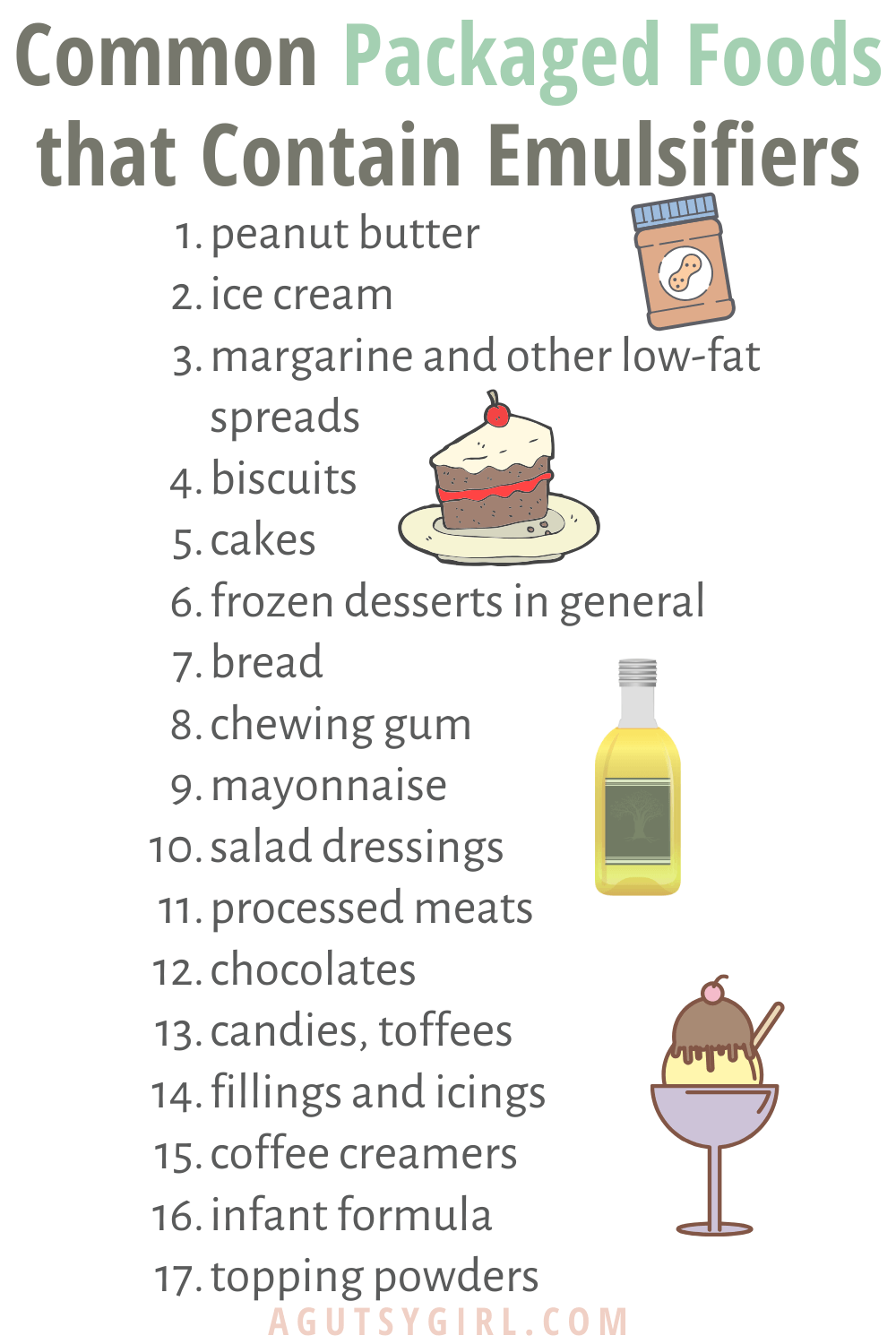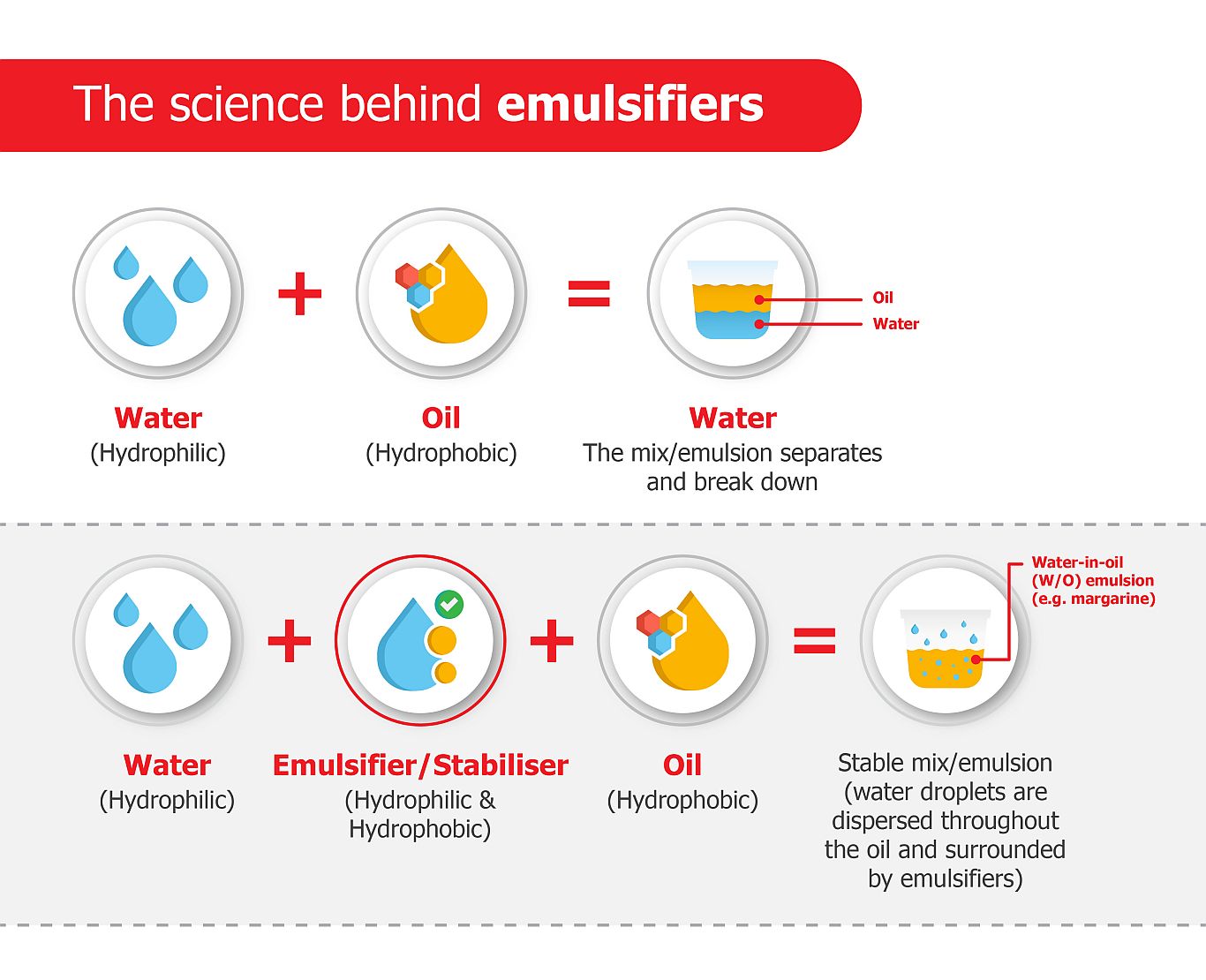How Emulsifier In Food Prevents Separation in Soups
All Regarding the Function of an Emulsifier in Food and Its Value in Modern Cuisine
Emulsifiers are critical in modern-day food, helping with the blend of immiscible liquids like oil and water. Their capability to support blends enhances the texture and flavor of different food. From salad dressings to baked items, emulsifiers play a substantial duty in both commercial and home cooking. Yet, the scientific research behind their function and the future technologies in their usage stay less discovered. Emulsifier In Food. What extra could be unearthed concerning these crucial culinary agents?
Recognizing Emulsification: The Scientific Research Behind the Process
Emulsification may seem like an easy culinary technique, it involves complicated scientific concepts that are vital for developing steady blends of immiscible fluids, such as oil and water. At the heart of this procedure exists the concept of surface tension, which avoids both fluids from mixing normally. Emulsifiers, substances that lower surface area stress, play an important function in helping with the combination of these fluids. They possess both hydrophilic (water-attracting) and hydrophobic (water-repelling) residential or commercial properties, permitting them to anchor themselves at the user interface in between oil and water.
When an emulsifier is introduced and the combination is upset, it develops a safety barrier around dispersed droplets of one fluid within the other, supporting the mix. This action not just improves texture and mouthfeel in foodstuff but additionally adds to their aesthetic appeal. Emulsifier In Food. Recognizing the scientific research behind emulsification is basic in modern cuisine, allowing cooks to produce a selection of sauces, dressings, and emulsified meals
Usual Types of Emulsifiers Utilized in Food
Emulsifiers are important components in the food market, playing a crucial function in stabilizing mixes of oil and water. Various kinds of emulsifiers are frequently used, each with unique residential or commercial properties suited for different applications. Lecithin, originated from soybeans or egg yolks, is just one of the most popular natural emulsifiers, typically found in delicious chocolates and dressings. Mono- and diglycerides, which are originated from glycerol and fatty acids, are commonly utilized in baked goods and margarine to improve appearance and prolong service life. One more common emulsifier is polysorbate 80, favored for its capacity to improve the uniformity of gelato and sauces. Furthermore, xanthan gum tissue and guar gum tissue work as thickening representatives that additionally add to emulsification in gluten-free products. These emulsifiers are important to creating a stable, tasty product in contemporary food formulas, making certain an enjoyable sensory experience for customers.
The Role of Emulsifiers in Numerous Food Products
A variety of foodstuff count on emulsifiers to attain preferred appearances and security. These substances help with the blending of immiscible fluids, such as oil and water, which is vital in several refined foods. For example, in salad dressings, emulsifiers help keep a consistent combination, stopping splitting up and boosting rack life. In baked items, they add to a consistent crumb framework and wetness retention, boosting total high quality.
Emulsifiers also play a considerable duty in milk items, such as gelato and yogurt, where they stabilize fat globules, ensuring a smooth mouthfeel. Additionally, in dressings and sauces, they boost viscosity and boost spreadability. This performance is vital in the production of delicious chocolates, margarine, and mayo, where a cohesive item is necessary. In general, using emulsifiers in numerous foodstuff is indispensable to modern food manufacturing, enhancing security and consistency across a large range of products.
Exactly How Emulsifiers Enhance Appearance and Taste

When incorporated right into food, emulsifiers considerably boost both texture and flavor, developing an even more satisfying eating experience. These materials facilitate the mixing of components that generally do not blend well, such as oil and water, causing a smoother, creamier uniformity. This not only improves mouthfeel however likewise enables flavors to distribute evenly throughout the product, enhancing the total taste.

Emulsifiers in Home Cooking: Tips and Techniques
Exactly how can home cooks properly make use of emulsifiers to enhance their recipes? Emulsifiers play a crucial duty in achieving desirable structures and tastes in homemade dishes. Making use of egg yolks in mayonnaise or hollandaise sauce enables for a secure solution, incorporating oil and water efficiently. Home cooks can also trying out mustard, which serves as an emulsifier in vinaigrettes, ensuring a smooth uniformity.
In baking, incorporating lecithin, discovered in egg yolks or soy, can improve dough security and moisture retention. In addition, using industrial emulsifiers like xanthan periodontal or guar periodontal can assist thicken sauces and dressings while keeping a velvety mouthfeel.
When developing ice lotions or whipped Clicking Here toppings, emulsifiers can prevent ice crystal formation, leading to a smoother texture. By mastering these strategies, home chefs can substantially boost their cooking developments, offering consistent and delightful meals that showcase the power of emulsification.
The Future of Emulsifiers in Culinary Innovation
As the culinary globe continues to develop, the role of emulsifiers is positioned to end up being progressively innovative and varied. Breakthroughs in food science are resulting in the development of new emulsifying representatives obtained from all-natural resources, which cater to health-conscious consumers and boost the sensory high qualities of meals. Technologies such as plant-based emulsifiers are getting grip, permitting cooks to create vegan and allergen-free choices without jeopardizing structure or taste.
Furthermore, using emulsifiers in molecular gastronomy is broadening, enabling cooks to explore one-of-a-kind structures and discussions that captivate diners. As sustainability becomes a concern, the future may see a shift in the direction of environmentally friendly emulsifiers that lower ecological impact.
Eventually, emulsifiers will remain to play an important duty in culinary development, bridging the space in between custom and modernity, and enabling cooks to press the boundaries of imagination in their cooking this contact form areas.
Frequently Asked Concerns

Are Emulsifiers Safe for Individuals With Allergic reactions?
Emulsifiers can be secure for people with allergies, depending upon their certain sensitivities. However, certain emulsifiers, obtained from allergenic sources like soy or eggs, may cause responses, necessitating careful explanation ingredient scrutiny and assessment with medical care experts.
How Do Emulsifiers Influence Food Life Span?
Emulsifiers enhance food rack life by maintaining combinations, stopping splitting up, and minimizing microbial development. This stability aids maintain structure and flavor with time, allowing products to remain attractive and risk-free for consumption longer than without emulsifiers.
Can Emulsifiers Be Derived From All-natural Sources?
Yes, emulsifiers can be stemmed from natural resources such as plants, eggs, and milk items (Emulsifier In Food). These all-natural emulsifiers assist maintain mixtures, enhancing structure and uniformity in numerous food applications while being liked for health-conscious customers
What Are the Environmental Effects of Emulsifier Production?
The environmental effects of emulsifier production include source depletion, environment devastation, and contamination from artificial procedures. All-natural emulsifier sourcing can minimize some effects, however in general, commercial methods still posture significant environmental challenges to communities worldwide.

Are There Vegan Emulsifiers Available out there?
Yes, there are a number of vegan emulsifiers offered on the market, such as lecithin stemmed from soy or sunflower, guar gum tissue, and xanthan gum tissue. These options deal with plant-based diets without compromising emulsifying homes.
Emulsifiers are crucial active ingredients in the food market, playing an important function in maintaining mixes of oil and water. A selection of food products rely on emulsifiers to achieve desired appearances and security. When incorporated into food items, emulsifiers significantly enhance both structure and flavor, creating an even more pleasurable consuming experience. Furthermore, emulsifiers can maintain air pockets in whipped products like mousses and creams, leading to a light and airy appearance. Emulsifiers improve food rack life by maintaining blends, stopping splitting up, and minimizing microbial growth.